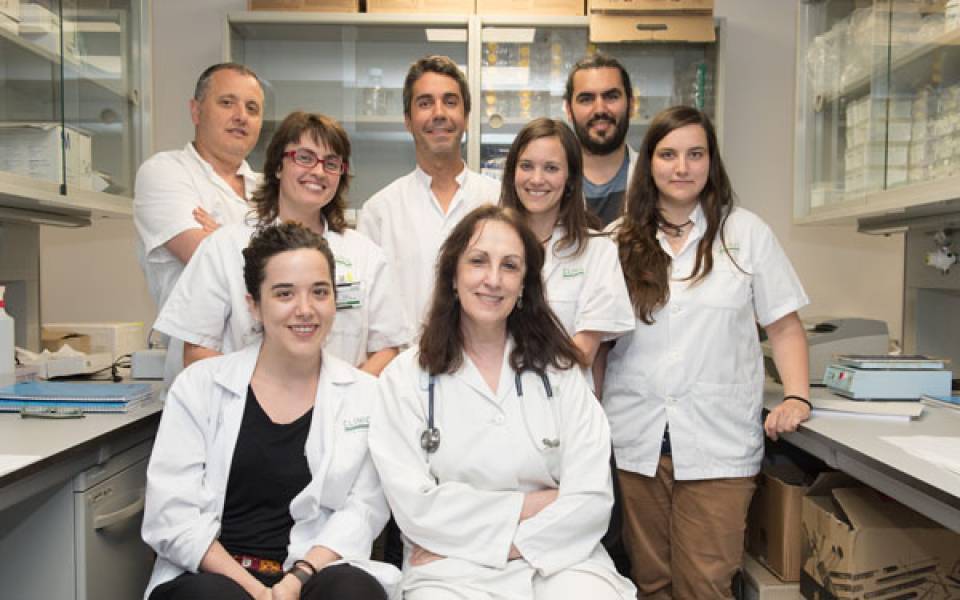The GCA is the most common type of primary systemic vasculitis, affects people over 50 years and has an unknown origin. It is a chronic inflammatory disease that affects the arteries. The most important complications are: blindness that occurs by the occlusion of blood vessels, which causes a significant dependency and lower quality of life in 15-20% of these patients; and aortic aneurysms that occur in 30% of patients during the follow-up period. Research on these diseases is focused on deeper understanding of the mechanisms involved in the perpetuation of the inflammatory activity in order to find therapeutic targets to stop it.
In the first article, published in the Annals of the Rheumatic Diseases, researchers have studied the role that plays interferon-gamma, a protein produced by T cells and activates cells of the immune system cells, in the GCA. The work was carried out with the sections of the temporal artery used in the diagnosis of the disease from 34 patients with GCA and 21 healthy people. Using a 3D culture system of these arteries, developed by the same research group, scientists have demonstrated the mechanism by which interferon gamma maintains inflammation in arterial walls. "Interferon induces cells from the vascular wall (smooth muscle cells) to synthesize molecules called chemokines that recruit more immune cells. These cells join adhesion molecules and become part in the inflammatory process. It also activates the macrophages recruited creating several inflammatory cascades. Using a fully human antibody designed for a therapeutic use to block this protein decreases the expression of these molecules and stops the progression of inflammation”, explains Dr. Marc Corbera, first author of the article.
In the second study, published in the journal Science Signaling and in which the National Institutes of Health (NIH) have collaborated, researchers have discovered a new pro-inflammatory function of the p19 subunit of IL-23. Until now it was believed that IL-23 was only functional when its subunits (p19 and p40) were secreted together, mostly by stem cells of the immune system. The study shows that when inflammation is present, endothelial cells from the small vessels that nourish the walls of the arteries, are able to only produce p19. This subunit acts at an intracellular level where it is able to activate STAT-3 and induce the production of adhesion molecules that are required for the recruitment of leukocytes and persistent inflammation. "This work breaks with the belief that p19 is only functional together with p40", explains Dr. Georgina Espígol, co-first author of the work, together with Dr. Ester Planas. "Current clinical trials in diseases such as psoriasis and ankylosing spondylitis, are using therapies with monoclonal antibodies to inhibit IL23 that may have no effect on intracellular p19 subunit. Thus it would be interesting to use in some patients other molecules inhibiting the signaling pathways that are activated”, she adds.
Reference articles:
Marc Corbera-Bellalta, Ester Planas-Rigol, Ester Lozano, Nekane Terrades-García, Marco A Alba, Sergio Prieto-González, Ana García-Martínez, Robert Albero, Anna Enjuanes, Georgina Espígol-Frigolé, José Hernández-Rodríguez, Pascale Roux-Lombard, Walter G Ferlin, Jean-Michel Dayer, Marie H Kosco-Vilbois, Maria C Cid
Ann Rheum Dis 2016;75:6 1177-1186 Published Online First: 23 December 2015 doi:10.1136/annrheumdis-2015-208371
Georgina Espígol-Frigolé, Ester Planas-Rigol, Hidetaka Ohnuki, Ombretta Salvucci, Hyeongil Kwak, Sarangan Ravichandran, Brian Luke, Maria C. Cid, and Giovanna Tosato.
Sci. Signal. 15 Mar 2016: Vol. 9, Issue 419, pp. ra28 DOI: 10.1126/scisignal.aad2357

